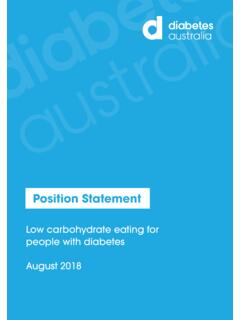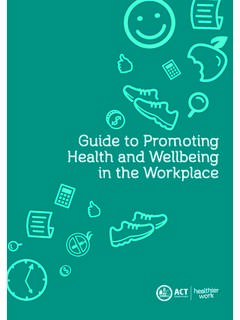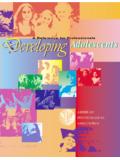Transcription of The Role of Schools in Preventing Childhood Obesity
1 ChildhoodOBESITYThe Role of Schools in Preventing Childhood Obesity Headlines across the nation proclaim news that educators have seen with their own eyes during the past two decades: children in the United States are getting heav ier and heavier. Accompanying stories in this issue of the Stan dard describe the negative consequences of this trend on the physical health and self-esteem of our nation s young people, as well as the financial burden that the Obesity epidemic is placing on our medical care system. The essential cause of the increase in overweight among children and adolescents is straightforward: an excess of caloric intake compared with caloric expenditure.
2 In other words, our young people are making unhealthy eating choices and are not getting enough physical activity. While the Surgeon General has identified the Obesity epidemic as one of the greatest health problems facing the nation today,1 educators have had their attention elsewhere. Today s Schools face intense pressure to focus on standardized tests and consequently have placed less emphasis on the broader view of a healthy mind in a healthy body. However, an increasing number of educators and school board members are realizing, as the National Association of State Boards of Education (NASBE) has written: Health and success in school are interrelated.
3 Schools cannot achieve their primary mission of education if stu dents and staff are not healthy and fit physically, mentally, and socially. 2 Thanks to the efforts of these educators and policy-makers, many Schools are making important contributions to our nation s struggle against the Obesity epidemic. This article summarizes data on overweight among young people and the role of Schools in addressing the issue, describes 10 key strategies Schools can use to improve student nutrition and increase physical activity, identifies important resources that can help Schools implement those strategies, and addresses chal lenges to change.
4 4 The State Education Standard | December 2004 by Howell Wechsler, Mary L. McKenna, Overweight among Children and Adolescents Since 1980, the percentage of children who are overweight has more than doubled, while rates among adolescents have more than tripled3,4 (see Figure 1). In 2002, 16 percent of 6 19 year-olds were Rates of overweight were higher among Mexican American boys ( percent), non-Hispanic black girls ( percent),6 and American Indian Non-Hispanic white adolescents from lower-income families are more likely to be overweight than their counterparts from higher-income In recent years, several weight-related conditions that were observed primarily among adults have been increasingly diag nosed in young ,10 For example, 10 years ago type 2 dia betes was almost unknown among young people.
5 But in some communities it now accounts for nearly 50 percent of new cases of diabetes among children or An estimated 61 percent of overweight young people have at least one addi tional risk factor for heart disease, such as high cholesterol or high blood Childhood overweight also is associat ed with social and psychological problems, such as discrimi nation and poor ,14 Furthermore, children and adolescents who are overweight are more likely to become overweight or obese Although child-onset overweight accounts for only 25 percent of adult Obesity , obese adults who were overweight as children have much more severe Obesity than adults who become obese in adult Obesity in adults is associated with increased risks of pre mature death, heart disease, type 2 diabetes, stroke, several types of cancer, osteoarthritis, and many other health One of the most harmful consequences of the Obesity epidem ic is the damage it does to our economy.
6 In 2000, the total cost of Obesity (including medical costs and the value of wages lost by employees unable to work because of illness, disability, or prema-Sarah M. Lee, and William H. Dietz ture death) in the United States was approximately $117 With the Centers for Disease Control and Prevention (CDC) estimating that more than one in three children born in 2000 will eventually suffer from diabetes,19 the future costs of weight-related health care could be staggering. The Role of Schools The physical activity and eating behaviors that affect weight are influenced by many sectors of society, including families, community organizations, health care providers, faith-based institutions, businesses, government agencies, the media, and Schools .
7 The involvement of all of these sectors will be needed to reverse the epidemic. FIGURE 1. Percentage of Children and Adolescents Who Were Overweight, * 1963-2002** 1963 1971 1976 1988 1999 6-11 years old 12-19 years old 1970 1974 1980 1994 2002 * >95th percentile for BMI (Body Mass Index) by age and sex based on 2000 CDC BMI-for-age growth charts. ** Data from 1963 70 are from 1963 65 only for children (ages 6 11 years) and from 1966 70 only for adolescents (ages 12 17 years). Source: National Center for Health Statistics. December 2004 | National Association of State Boards of Education 5 Schools cannot solve the Obesity epidemic on their own, but it is unlikely to be halted without strong school-based policies and programs.
8 Schools play an especially important role because: Over 95 percent of young people are enrolled in Promotion of physical activity and healthy eating have long been a fundamental component of the American educa tional experience, so Schools are not being asked to assume new responsibilities. Research has shown that well-designed, well-implemented school programs can effectively promote physical activity, healthy eating , and reductions in television viewing Emerging research documents the connections between physical activity, good nutrition , physical education and nutrition programs, and academic What Can Schools Do to Make a Difference?
9 Most important, Schools can help students adopt and maintain healthy eating and physical activity behaviors. CDC has published guidelines that identify school policies and practices most likely to be effective in promoting lifelong physical activity and healthy ,33 The guidelines, which are based on comprehensive reviews of the research literature and extensive input from academic experts and school health practitioners, contain many different recommendations that can be summarized as 10 key strategies. 1. Address physical activity and nutrition through a Coordinated School Health Program (CSHP) approach. A CSHP integrates efforts of the eight components of the school community that can strongly influence student health: (1) health education; (2) physical education; (3) health serv ices; (4) nutrition services; (5) counseling, psychological, and social services; (6) healthy school environment; (7) health promotion for staff; and (8) family and community involve ,35 CSHPs focus on improving the quality of each of these components and expanding collaboration among the people working on them.
10 A CSHP is a systematic approach to promoting student health that emphasizes needs assess ment; planning based on data, sound science, and analysis of gaps and redundancies in school health programming; and evaluation. This model has been embraced by education agencies in most states, including 23 state education agencies that are currently funded by CDC to establish state-level infrastruc ture to implement statewide CSHPs. More information about this model and state activities to promote physical activity and healthy eating through CSHPs is available at the website of CDC s Division of Adolescent and School Health: 6 The State Education Standard | December 2004 The adoption of policies at the school, school district, state, or federal level is critical to the effective implementation of the nine other strategies listed in this article.
















